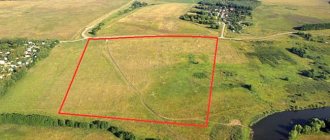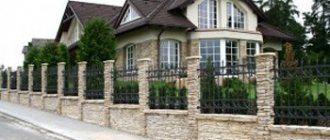What is considered a semi-detached house by law?
The norms of the Russian town planning code define several types of low-rise residential development. One of these types of housing is blocked houses.
The main definitions and technical provisions relating to blocked residential development are given in the Town Planning Code of the Russian Federation (Article No. 49, Part 2):
A blocked
residential building
is an apartment-type building consisting of two or more apartments, each of which has direct access to the adjacent plot. The building itself is considered a single house, although it consists of several, essentially autonomous residential blocks.
We will look at all the differences and rules for the development and operation of blocked houses a little later. Now let's move on to the background - how did this type of housing appear and why is it so in demand?
Important! From the above solutions, some conclusions can be drawn.
If it becomes necessary to recognize a house as blocked, the first step should be to contact the cadastral registration authorities, and not to the court. They are the ones who classify real estate as one type or another. In the event of an unlawful refusal, you will have to collect evidence that there is a technical possibility for the autonomous existence of each section in the house and appeal the unlawful refusal in court. It cannot be assumed that independent access to land plots will be sufficient to satisfy the claim.
History of the format
This format of low-rise buildings first appeared in England and France, and received special development in the 17th – early 20th centuries.
Thus, the first street consisting entirely of interlocking buildings appeared in Paris in the early 1600s. In Britain, such development began to be widely used in urban planning after the great fire that occurred in London in 1666.
Since the late 18th and early 19th centuries, when Britain was undergoing massive urbanization, standard block housing has become prevalent in growing industrial centres. In conditions of large population concentrations and lack of space for the construction of individual households, this type of housing has become widely in demand.
Other obvious advantages of block development are:
- Significantly lower cost per square meter;
- Improved layouts, often larger area;
- More comfort compared to apartments, using some of the advantages of a country house (such as its own plot, separate entrance, etc.);
As a result, by the end of the 19th century, most cities in Great Britain began to consist of long rows of narrow streets lined with block-type houses.
Then, from England, semi-detached residential development “migrated” to other countries and territories associated with the British Empire: to the USA, India, Australia. Also, this type of residential buildings has become widespread in Scandinavia and Germany.
How to recognize a house as a block house?
Why is this necessary? The fact is that the owners of blocks in such a structure also have ownership rights to part of the local area. The same cannot be said about the residents of an apartment building.
To recognize a residential building as a blocked building, the first step is to make a corresponding request to:
- BTI.
- Local administration.
- Courts.
Accordingly, all these stages should be completed sequentially. Court - only if the first two steps are unsuccessful.
As practice shows, the judicial system recognizes a house as a block, sectional one with the following combination:
- The building stands alone and has no more than three floors.
- Each block, section is intended for residence of one owner, one family.
- There are no unified intra-house systems or property for common use by the owners.
- Utilities (water supply, heating, sewerage, electricity, etc.) are provided to block owners directly by the supplier.
- General equipment is located behind the walls of the residential sections to serve units independent from them.
What are the differences between a blocked house and an apartment building?
Being essentially a low-rise building with several apartments, a semi-detached house can be quite difficult to distinguish from ordinary multi-apartment residential complexes. However, it has several major differences.
Thus, according to the law, a blocked building must meet the following requirements:
- The number of floors in the house should be no more than 3;
- The total number of blocks in the building should be from 1 to 10;
- Each of these residential blocks is designed for autonomous living of one family, and is a separate comfortable apartment;
- Neighboring apartments (blocks) are separated from each other by blank walls, without doorways;
- Residents of semi-detached houses do not have common property (i.e. common entrances, attics or basements, communication shafts, etc.);
- Each family has a separate exit to the local area, without a common corridor or entrance (front door).
The main difference between blocked buildings and a standard apartment building, from the point of view of Russian legislation, is the design of the local area. If all the land under a multi-apartment residential complex is registered as 1 plot, then in semi-detached buildings a separate plot of land is registered for each block.
There is also quite often confusion in the use of terms: what is “block housing”? Are they the same thing as "townhouses" or "duplexes"?
Blocked residential development - type of land use and purpose of the public housing complex
“Blocked residential development” means the type of permitted use of land plots and a property with the status of a residential building.
Blocked residential building - VRI ZU
In the master plans of settlements and land development zones, the residential development zone is divided into territories. For the residential development zone, the dominant types of land use are determined:
- individual housing construction (IHC)
- low-rise buildings
- personal plots of personal subsidiary plots (LPH)
- blocked residential development
- mobile housing
- mid-rise residential development
- multi-storey residential development (high-rise development)
- residential development maintenance
Blocked residential development is one of the typical types of land use in populated areas. More precisely, this is a VRI ZU in part of the territorial zone of residential development.
Blocked residential development – real estate object
The current VRI ZU Classifier (approved by Rosreestr Order No. P/0412 dated November 10, 2020) is the main guideline when analyzing the possibility of developing plots within a populated area.
The type of use of the plots “blocked residential development” was assigned code 2.3. Its description indicates that plots with such VRI can be used:
- for the construction of a residential building suitable for permanent residence: house:
- not divided into apartments
- no higher than 3 above-ground floors
- the floors have a common wall without openings with the neighboring house
- the number of combined houses in this “common house” is no more than 10
- ornamental and fruit trees
- garages
- sports and children's playgrounds
On a site with VRI “blocked residential development” it is allowed to build:
- residential building consisting of a maximum of 10 combined blocks
- garages
- auxiliary structures
What are semi-detached houses?
Combined houses are a hybrid type of low-rise residential buildings. These are residential buildings of the same type located in a row, blocked with each other by side walls.
Each of the autonomous blocks has:
- separate entrance
- small plot (front garden)
- garage (often)
Blocked buildings do not belong to the class of apartment buildings in which:
- the exit from your own apartment leads to the front door (a public place)
- exit from the front door - into the territory (ZU)
- the plot is owned by all residents of the house
In combined houses, each block has its own access to a private plot, which can have its own garage.
Common types of residential blocked development:
- duplexes
- townhouses
- lanehouses
- quad houses
- british houses
They differ in architectural solutions and internal layouts.
Land plots adjacent to the blocks
Developers of a blocked house have questions about the original memory:
- How is it distributed between shared houses?
- what should its area be?
The answer to them is in the Town Planning Code of the Russian Federation (subparagraph 2 of paragraph 2 of Article 49):
Residential buildings of blocked residential development meet the requirements:
- number of floors – no more than 3
- number of blocks – no more than 10
- each block: intended for one family
- has a common wall/walls:
- without openings with the adjacent block or adjacent blocks
- walls - no windows or doors
- located on a separate memory
- has access to a public area
Regarding the original land plot it is said:
- Each block has its own memory
- each block with isolated access to the common area
The original land plot on which the blocked development will be built must undergo some changes.
Formation of land plots
Since each block of a residential building in a blocked development must be located on a separate plot, the plots for the blocks are:
- are formed from the original section:
- when surveying
- when determining their boundaries
- are registered upon completion of cadastral work
VRI ZU, occupied by blocks, must comply with the legal regime of combined houses. The name of the VRI of the block site is “blocked residential buildings”.
When forming a memory for blocks, you need to take into account that:
- the boundaries of adjacent areas are established from the common walls of the blocks during land surveying
- the section of the original memory is carried out along the lines of the walls
- the number of generated memories must correspond to the number of blocks
- the dimensions of block land plots must comply with the requirements of urban planning regulations: the established maximum plot sizes for VRI “blocked residential development”
Information about block plots will be reflected in the future in the sections of the permit for the commissioning of a residential building of a blocked development (letter of the Ministry of Economic Development of Russia No. D23 i-1328 dated March 14, 2017).
A residential building of a blocked development is a single building:
- from low-rise buildings of the same type
- with common walls between neighboring buildings
Each block is a residential building with a certain specificity. It is reflected in the Housing Code of the Russian Federation (clause 2 of Article 16).
Land plots for each block must comply with the requirements for maximum land plot sizes. It is more convenient to explain all this with examples:
№1
- the established maximum minimum storage size is 10 hundred.
- the area of the original site is 20 acres.
maximum number of blocks – 2
area of block storage units – 10 hectares.
№2
- the established maximum minimum storage size is 4 hundred.
- The area of the original site is 16 acres.
maximum number of blocks - 4
block storage area – 4 acres.
№3
- the established maximum minimum storage size is 10 hundred.
- The area of the original site is 16 acres.
It is impossible to build a blocked residential building on the site:
- with a minimum number of blocks (2) it turns out: the area of the block storage is 8 hundred.
- non-compliance with the requirements of urban planning regulations
The area of the land plot adjacent to each block of a residential building should not be less than the minimum limit established by the town planning regulations for residential development in the settlement's land use zone.
Blocked residential building on an individual housing construction plot
If there are no particular problems with the structure itself:
- it is suitable for residential purposes
- the status of “blocked residential building” can be established using the technical plan of a capital construction project based on the BTI passport
then the question of whether the type of permitted use of the original site and its area allow for blocked construction remains to be analyzed.
VRI ZU for a blocked residential building must correspond to the name of the type of use according to the VRI Classifier. It should not be anything other than “blocked residential development”.
This means that you will have to find out whether or not it is possible to change the existing VRI “for individual housing construction” to the form “blocked residential development”. Otherwise, construction on a site intended for individual housing construction will not comply with the VRI of this site.
Will help with this:
- extract from the PZZ about the VRI ZU for the territorial zone in which the allotment is included
- materials of the urban planning plan of the land plot (GPZU)
Both documents contain lists of main, conditionally permitted and auxiliary VRI memory. From them you can choose the type that is suitable for the task at hand.
It is possible that the VRI “blocked residential development” will not be on the list. Then it will be necessary to clarify the possibility of changing the territorial zone of the land plot to the zone where the required species is present in the main or conditionally permitted VRI.
Regarding the area of block plots you need:
- find out the maximum size of the land plot for a blocked residential development, established by the city regulations
- compare the areas of future plots adjacent to the blocks with the maximum size
Example
The established minimum storage size is 10 cells.
- build a blocked residential building on a land plot with an area of 15 acres. will not work
- on a storage area of 25 acres. you can build a house with 2 blocks
In order to allocate land plots for each block of the house, it will be necessary to carry out land surveying work on the original site.
Permission to build a blocked residential building
The construction of a blocked residential building must be carried out on a single original plot of land (or on several adjacent land plots for blocked residential development). Permitting documentation is issued taking into account this situation (Letter of the Ministry of Economic Development of Russia No. D23 i-5649 dated November 28, 2013).
If several owners of land plots make a joint decision on blocked development. To obtain permission you must:
- combine areas into one
- prepare a boundary plan for the formed land plot
- put the land plot on cadastral registration
The division of the original site into block land plots is carried out before putting the blocked residential building into operation. A boundary plan is drawn up for each established land plot.
Construction permit
- confirms compliance of design documentation with urban planning requirements
- certifies the compliance of the planning scheme with the location of the building
- gives the developer the right to construct/reconstruct a capital facility
When preparing a permit, controversial issues are identified and eliminated. For carrying out construction work without it, administrative liability is provided,
The absence of a building permit excludes:
- registration of an object for cadastral registration
- registration of rights
Procedure for obtaining permission
There are no simplified procedures regarding the construction or reconstruction of blocked houses.
General rules apply:
- preparation by the owner: materials for obtaining GPZU
- project documentation
- for the construction of the facility
GPZU is issued on the basis of completed work on territorial planning and land surveying. The plan contains information:
- about the boundaries of the memory
- about minimum offsets from boundaries
- on the areas of public easements
- on the permitted use of memory
- requirements:
- to appointment
- to OKS parameters
- to placement of OKS on the storage
- on technical conditions for connecting OKS to engineering support networks
GPZU is the starting document in the process of preparing for the construction of a block residential building. In the application for its provision, you can indicate the planned number of blocks.
The received GPZU must provide for the allocation of a land plot for each block of a residential building.
The urban planning plan of a land plot is the basis for preparing a scheme for the planning organization of a land plot (SPOSU). The diagram indicates:
- location of a blocked residential building
- places of entrances and passages
- boundaries of coverage areas: public easements
- ZOUIT
The development of the SOPSU is carried out in accordance with:
- with the PZZ norms for the territorial zone to which the original land plot belongs
- with the requirements of regulatory documents: SP 30-102-99 “Planning and development of low-rise construction areas”
- SP 42.13330.2016 “Urban planning. Planning and development of urban and rural settlements"
- SNiP 02/31/2001 “Single-apartment residential houses”
- “Regulations on the composition of sections of project documentation and requirements for their content” Decree of the Government of the Russian Federation No. 87
The SPOSU is agreed upon with the chief architect of the municipal administration. The following is also agreed upon with him:
- design materials
- diagrams of architectural solutions for a blocked residential building (building facades)
Since a blocked residential building is a capital construction project, the procedure for obtaining permission for its construction must also comply with the requirements of Article 51 of the Civil Code of the Russian Federation. The only exception to this is the absence of a requirement for an examination of project documentation.
Documents for obtaining permission for blocked development (clause 7 of Article 51 of the Civil Code of the Russian Federation):
- statement
- title documents for land plots
- GPZU issued no earlier than 3 years before the date of submission of the application
- project documentation materials:
- explanatory note
- SPOZU
- diagram of the planning organization of a land plot with the location of a linear object within the red lines approved as part of the territory planning documentation in relation to linear objects
- architectural solutions
- information about engineering equipment
- summary plan of engineering support networks with designation of places of technological connection of the designed OKS
- projects: construction organizations of OKS (POS)
- organization of demolition or dismantling of OKS and their parts
- provided that the examination of the design documentation of the specified objects was not carried out in accordance with Article 49 of the Civil Code of the Russian Federation
- in case the developer was granted permission in accordance with Article 40 of the Civil Code of the Russian Federation
Putting a blocked residential building into operation
The legal status of a residential building in a blocked development is distinguished by:
- separate ownership of each component of the building (block).
- location of each block on a separate memory (clause 2 of part 2 of article 49 of the Civil Code of the Russian Federation)
A mandatory attachment to the application for permission to put the facility into operation is the OKS technical plan. Its preparation is carried out by the applicant (Article 24 of the Federal Law “On State Registration of Real Estate” No. 218-FZ).
Each block is a capital construction object:
- the number of technical plans for parts of blocked development must be equal to the number of blocks
- the number of memories must be equal to the number of blocks
Information about land plots adjacent to the blocks is included in the sections of the permit for putting a residential building of blocked development into operation.
To put a blocked house into operation, it is necessary to perform a number of measures:
- preparation of technical plans for blocks as capital construction projects (part 10.1 of article 55) of the Civil Code of the Russian Federation)
- State cadastral registration of blocks:
- as a separate building with the purpose of “residential”: Letter of the Ministry of Economic Development of Russia No. D23i-1328
- SNiP 02/31/2001
Reasons for accounting for blocks in the State Property Committee:
- permission to put a residential building in a blocked building into operation
- technical plans of blocks
Reasons for suspending cadastral registration of blocks
- permission to put a capital construction project into operation was issued in relation to a blocked residential building, but the technical plan was prepared in relation to a multi-apartment residential building and premises (apartments)
- in the permit to put the facility into operation:
- the main characteristics of the blocks are missing (total area)
- only the number of blocks is indicated
Features of blocked development
Features of a blocked development as a real estate property with a land plot:
- the blocked house should be no higher than 3 floors
- the building of the house consists of combined houses, blocked with each other by side walls
- each block: recognized as a residential building
- placed on the cadastral register as a separate residential building
- Each block has an adjacent plot
- at least 2
- no common doors or entrances
- or to your own memory
- attic
Attractive factors for residential buildings in blocked development
- high cost-effectiveness of construction
- low costs: for the construction of external walls
- provision of engineering communications
- the more blocks there are in the house, the more profitable they are to purchase
Helpful information
- The provisions of the upcoming “garage amnesty” 2021 – 2026 can be found here
- Risks from establishing red lines on a land plot – here
- What is a land encumbrance can be found here
- Land tax for individuals from 2021 – here
- What can be built on plots for peasant (farm) farming (peasant farming) - read here
- How plots of lifelong inheritable ownership (LIP) are used – here
- The conditions for registering ownership of seized land can be found here
- How land plots in protected zones of cultural heritage sites are used and developed can be found here
- You can find out about the new VRI Classifier - 2021 here
- Why the “forest amnesty” is interesting for land owners – read here
- The characteristics of capital and non-capital (temporary) objects can be found here
- The calculation of taxes on real estate according to the new rules for 2019 can be found here
- A simplified procedure for the construction/reconstruction of residential buildings on individual housing construction plots, private plots, as well as garden and summer cottage plots - you can find it here
- The rules for demolishing unauthorized buildings under the new 2018 law can be found here
- An idea of the town planning regulations and its significance for the development of land plots can be found here
Regulatory framework
The procedure for operating semi-detached housing, as well as construction and technical standards, are determined by the following legal acts:
- Housing legislation of the Russian Federation. It contains the basic concepts and definitions of block houses, and their operational and technical characteristics;
- Town Planning Code (Article No. 49). Contains a precise and comprehensive definition of semi-detached development;
- Decree of the Government of the Russian Federation No. 220, dated 2015, establishing the procedure for purchasing blocked housing on the primary market;
- Federal Law No. 161, as well as Order of the Ministry of Construction No. 223, defining the rules for the provision of land plots for the construction of combined residential buildings;
- Land Code of the Russian Federation (Article No. 35), which regulates the procedure for legal registration of plots intended for block development;
- Letter from the Ministry of Economic Development stipulating the procedure for placing interconnected buildings on one plot of land.
In accordance with these legal acts, a full range of legal registration of blocked development is carried out, starting from the allocation of land for construction, and ending with the purchase and registration of finished housing.
Examples of block houses
Here are the most common examples of sectional buildings:
- Townhouse. The building is usually located within the city, but has all the signs of suburban housing: a small apartment area, two floors, a vertical layout, and the presence of its own plot of land in front of the exit.
- Violet. Also a townhouse, but of an elite type. There is a private terrace, an outdoor swimming pool, a garage, a veranda, and a large local area.
- Lanehouse. This is the name for block houses with a small living space. Typically each unit has its own attached garage.
- Duplex. Two-story block houses designed for two owners, with a blank wall between the sections. Only the roof will be common.
- Quad house. These are four separate blocks connected by common walls. Each has its own exit, garage, garden plot.
Blocked house - is it private or shared?
This is one of the most common questions that causes confusion and uncertainty among all those who are planning to buy a townhouse or duplex, or have already purchased. What is private in such houses and what is common?
There is simply no answer to this question. Due to the “youth” of this housing format on the Russian market and the large number of regulatory documents, many of them provide vague definitions, or even completely contradict each other.
Technical plan of a block house
The technical plan of a sectional house is drawn up in accordance with Art. 24 Federal Law No. 218. Without this document, the building cannot be put into operation. The technical plan should include the following:
- Complete information about the building, which is necessary for its cadastral registration.
- Information about each block (this is also required for cadastral work).
- Data about the building with an already assigned cadastral number. This is already for making an entry in the Unified State Register.
The technical plan consists of a text and graphic section. The latter is a cadastral plan of the territory or an extract from the Unified State Register of the land plot on which the sectional building is located, with a description of its location.
Let us also draw your attention to Rosreestr letter No. 14-02689-GE/17:
- Each block of a sectional house put into operation is registered in the cadastral register as a separate residential building.
- It follows that each section must have its own technical plan. This entails the fact that a certain plot of land is assigned to the block.
- The basis for recording sections in such a house is permission to commission the entire building and a technical plan drawn up for each block.
How to assign the status of shared housing to your home?
In order for your home to be recognized as a blocked house, it must meet the requirements written down in the land code and town planning code:
- This house should not have more than three floors;
- The house must consist of no more than 10 separate blocks and have at least one common wall, each block must have its own exit and its own area.
If the housing meets these requirements, you can complete all the necessary documents by submitting applications to the following authorities:
- Bureau of Technical Inventory;
- City or other council (governing body);
- Court bodies that specialize in awarding housing status.
State cadastral registration of blocks
Rosreestr in the same letter says that technical plans need to be prepared for each block of a residential building in a blocked development. It is important to remember that each block has its own plot of land. Data about them will then be reflected in the relevant sections of the permit for putting a residential building in a blocked building into operation.
It turns out that the basis for accounting for blocks in a residential building of blocked development will be:
- permission to put the house into operation,
- technical plans for each block.











